A new national survey has laid bare the economic strain facing millions of households, showing how falling incomes, limited job opportunities and rising costs, made worse by the Finance Bill, are reshaping everyday life.
“In looking at these figures, however, it should be recalled that even if the rate of inflation has fallen to under 4% annually from over 9% three years ago, the total/accumulated rate over these years has been close to 20%, thereby decreasing the purchasing power of whatever earnings end up in Kenyans’ pockets (and/or bank accounts),” TIFA notes.
Just a quarter (25%) of adults work in full-time jobs, while 23% rely on self-employment and 15% work part-time. According to TIFA, “this leaves nearly one-in-four jobless, whether or not they are actively seeking employment”
Such limited options have contributed to what the report describes as a “clear rise in those reporting worsening circumstances,” with young people and urban workers particularly affected.
The income gap has worsened inequalities in facets of daily life such the choice of cooking fuel. Nationally, firewood remains the most common cooking fuel (41%), followed closely by LPG (37%). But geography and income determine access.
“There is a marked contrast between urban and rural dwellers, with a considerable majority of the former using LPG –nearly three times more than their rural counterparts (66% vs. 23%).” Income plays a decisive role: only 38% of households earning under KSh10,000 use LPG, compared to 89% of those above KSh100,000
The report further notes a long-term shift: over the past decade, wood use has steadily declined while LPG has expanded, aided by public education and the elimination of VAT on gas. “If this trend continues, it should not be long before their places are reversed,” TIFA says.
Despite state measures to limit new taxation in this year’s Finance Bill, now Finance Act, the annual taxation review has had lingering effects, and is viewed negatively. Two-thirds of Kenyans (65%) say they have been directly affected, though the figure is higher in Coast (82%) and Nyanza (81%), and lower in Northern Kenya (44%).
Among those impacted, the overwhelming majority point to negative consequences: “increased cost of basic goods and services” (82%), “reduction of disposable income or savings” (31%), “increased taxes on salary or income” (21%), and “more difficulty sustaining businesses” (19%). Only 12% felt it enabled the government to improve public services

Leave a Reply